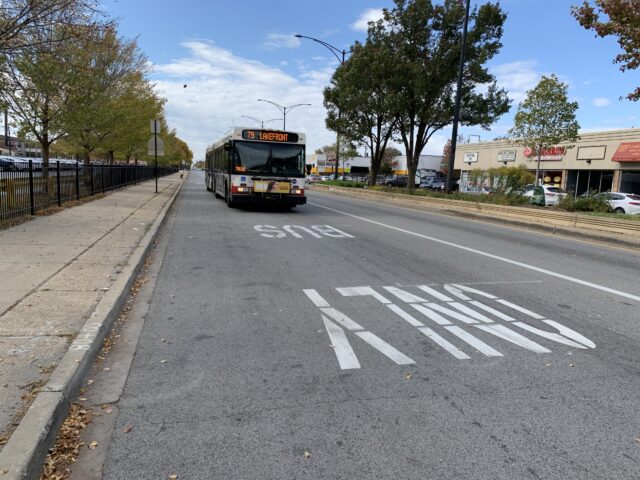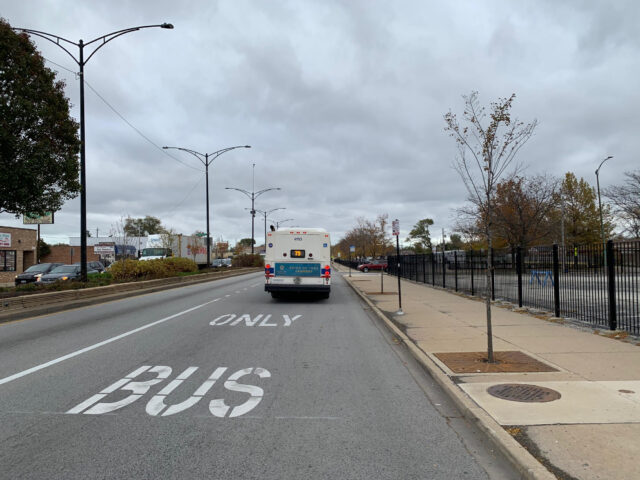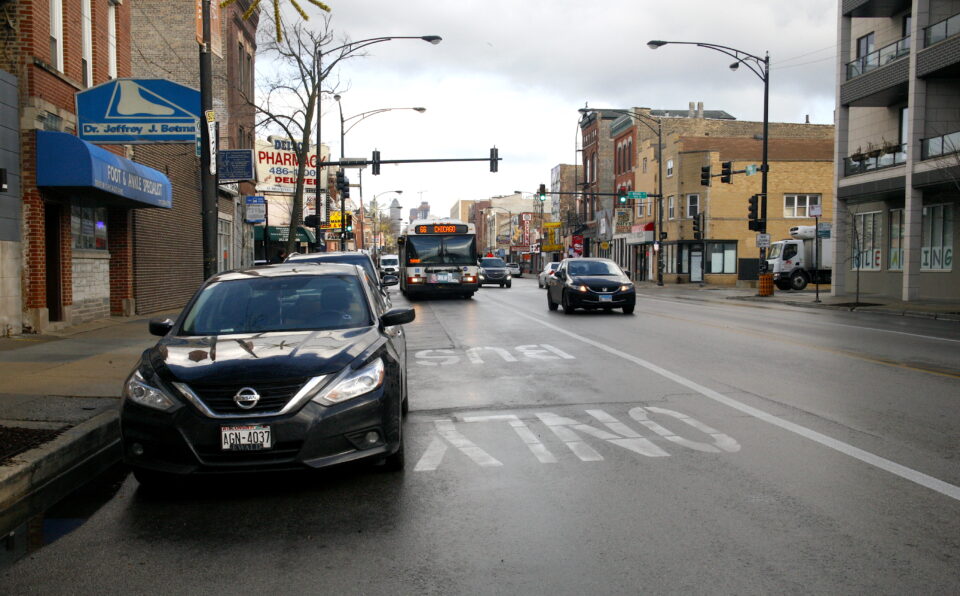
Pop-up bus lanes on 79th Street, Chicago (credit: Chicago Transit Authority)
Project Length: 7.6 miles total.
3 miles along 79th street from Cicero to Western.
4.6 miles along Chicago Avenue, from Laramie to Ashland.
Right-of-Way Width: 79th Street: 79’, 12’ lanes.
Chicago Avenue: 56’, 10’ lanes
Participating Agencies: Chicago Department of Transportation, Chicago Transit Authority
Timeline: 2020
Cost: $180,000.00
Goals
Speed up buses for essential riders: These bus lanes were built as part of Chicago’s COVID-19 response strategy. They are intended to improve travel times and increase safety for riders who have needed to continue using transit throughout the pandemic to reach essential jobs or make essential trips to grocery stores, medical appointments, etc. By creating dedicated space for buses to run along longer uninterrupted street segments, the lanes are intended to keep buses operating at regular intervals and reduce bus delays and bunching, thereby limiting the risk of crowding and promoting safe social distancing on board vehicles.
Improve transit on priority corridors: Both corridors already have some transit priority treatments as part of Chicago’s Bus Priority Zone Program, a joint CTA/CDOT initiative to improve bus travel times and increase reliability on core routes. Existing improvements include signal timing optimization, queue jumps, curb extensions to shorten crossing distances, and curbside bus lane spot treatments.
Pilot new treatments and materials: CDOT is testing new bus lane configurations and installation materials, including: a durable, but temporary, tape to mark the bus lanes and installing the lanes in a standard travel lane, aka the “offset” lane. Previously, Chicago has used the lane along the curbside for other on-street transit priority treatments.
Overview
Chicago’s pop-up essential bus lane pilots were implemented on corridors that serve two of the highest-ridership bus routes in the city: along Chicago Avenue (#66) and 79th Street (#79). These temporary, 24-hour dedicated lanes were made by converting travel lanes to bus-only lanes in both directions.
The Chicago Department of Transportation (CDOT) and Chicago Transportation Authority (CTA) launched the pop-up essential bus lanes as part of their COVID-19 pandemic response. Transit-only lanes help reduce bus delays and bunching by carving out a dedicated space for buses to operate on a city street. As COVID-19 caused ridership to plummet throughout much of CTA’s rail system, bus ridership on many key routes throughout the city retained a higher proportion of its typical ridership levels, particularly in Chicago’s South and West sides.
As part of its overall response to COVID, CTA took action, where possible, to adjust its operations to reduce the risk of crowding. This action included running articulated buses on routes that maintained higher ridership levels, changing loading standards to limit the number of passengers on board, and reallocating service.. To further reduce the risk of crowding, CDOT and CTA worked together to pursue bus-only lanes on 79th Street and Chicago Ave because on-street transit priority treatments are another powerful tool to further reduce the possibility of traffic delays for Chicago’s bus riders.

Pop-up bus lanes on 79th Street, Chicago (credit: Mike Claffey, CDOT)
Design Details
The bus lanes on both corridors are designed to prioritize bus service for essential workers and essential trips along two of Chicago’s highest ridership bus routes. CTA and CDOT selected 79th Street and Chicago Ave because they served existing high-frequency bus routes, maintained relatively high ridership throughout the course of the pandemic, and had previously received transit priority investments from the City. CDOT reallocated one general purpose lane in each direction for buses only, operating 24-hours per day as a 6-month pilot.
Because these lanes were built as a pandemic response strategy, implementing them quickly was a priority. Staff were able to plan, design, and construct the bus lanes on a fast timeline–from initial discussions in May, to construction completion in November–by adjusting their conventional bus lane design, testing new materials, and contracting with vendors already in place with the city.
The pop-up essential bus lanes are offset lanes. This configuration offered several advantages in two contexts: first, because the existing curb lane remains, no changes were needed to on-street parking inventory, loading zones, or curb regulation. General traffic is permitted to enter the bus lane for right turns and to access driveways and parking. The existing right-most travel lane was already wide enough for comfortable bus operation (the curb lane is 8 feet on each street, which would have required rebalancing of lane width to accommodate buses). Stops did not need to be modified. And traffic analysis volumes and field observations for the projects indicated that a general purpose lane could be dedicated to buses on each street without requiring signalization changes. The bus lanes are marked with Temporary Pavement Marking Tape, which is quick to install but expected to be durable enough to last for the 6-month pilot period (including a Chicago winter). Finally, the installation contractor was already under contract with the city and had familiarity with rapid deployment and CDOT-led pilot projects, accelerating the project delivery timeline further.
The bus lanes are marked with a solid line replacing the previous skip dash lane line, with bus only lettering centered in the lane. For cars turning at intersections, skip dash lines mark the end of the bus lanes, allowing private vehicles to merge and turn from the bus lane. At bus stops, skip dash lines are also lengthened, giving buses more room and cars the space to move over. Signage will be spaced at 0.5-mile intervals in both directions along both corridors to clarify lane usage and indicate the lanes are part of Chicago’s COVID-19 recovery planning. Because the focus was strictly geometric, no changes were made to signals or stop locations.
Keys to Success
Think creatively and tap into internal expertise: A number of the unconventional time-saving elements of this project were suggested by agency staff in different departments, including the use of temporary tape to mark the bus lanes and working with contractors already under contract with the city to expedite installation.
Inter-agency coordination is key, but requires flexibility and strong staff ownership to deliver on a rapid timeline: Because the delivery timeline was so compressed, CDOT and CTA relied heavily upon existing coordination muscles to deliver the two streets effectively. Project coordination between CTA and CDOT was conducted on an ad hoc basis — staff connected when time-sensitive questions came up, but there were not standing meetings or codified checkpoints to help systematize project delivery. Project staff needed to be agile, creative, and trust that their peer agency counterparts were working with a shared mission.
Outcomes
Rapidly planned, designed, and built two transit-priority corridors on existing key bus routes to serve essential workers and transit riders during the COVID-19 pandemic.
Enabled the development of new project delivery treatments and techniques, including materials testing, offset transit-priority lanes, and use of contractors from other rapid response projects.
Staff are monitoring the before and after performance of the lanes. Based on the results of the 6-month pilot, future initiatives may be considered.

Pop-up bus lanes on Chicago Ave, Chicago (credit: Emily Drexler, CTA)